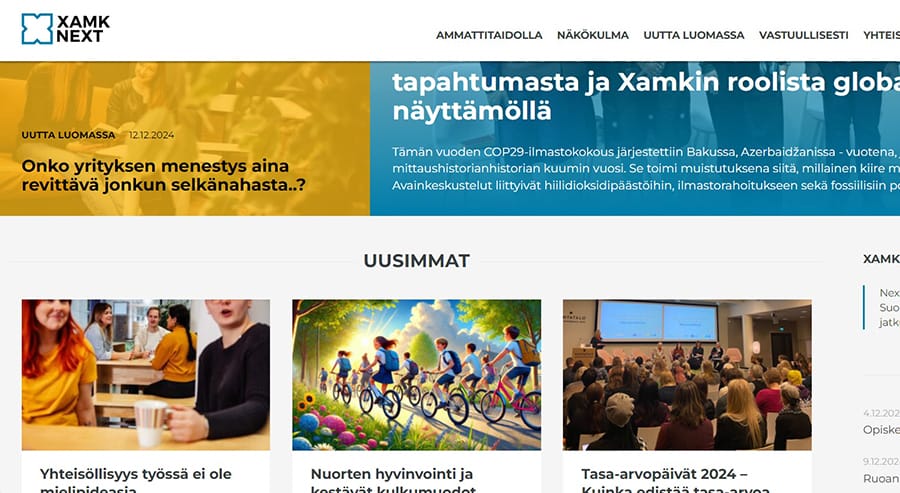Factors influencing the choices of international applicants to Finnish University of Applied Sciences
The competition has further intensified due to large number of offerings from other disruptive mediums (e.g. MOOC courses, online programs), recent introduction of tuition fees in many programs, and widening offerings available for an international student globally. By correctly identifying the decision-making factors of international students in applying to universities in Finland, it can be possible to design appropriate marketing programs to attract and retain them.
Understanding students’ perspective
Within this context, I recently conducted a survey among students currently enrolled in Finnish University of Applied Sciences (UAS)s (not necessarily confined to XAMK) among which 96% (N=68) of the respondents were enrolled in a Bachelors level program out of which 87% were studying full-time.
50% of the respondents have been studying for 1 year or less, 37% for 2 years already and the rest for more than 2 years in their respective programs. Most of the students (74%) were enrolled in business or economics related programs, 21% in engineering related programs and the rest in other types of programs.

Further, 65% of the respondents were male and the rest were female. Most of the students (54%) were within the age range of 21-25 years of age, 24% were less than 20 years of age and the rest were above 25 years of age. The respondents were from various countries including Vietnam, China, Nigeria, Nepal, India, Russia, Ghana and other European countries.
When asked about their main reason to decide to study abroad, majority (72%) indicated that it is to gain cross-cultural experience. The other main motivating reasons were the poor quality of education and the unavailability of the desired program in their own country and the possibility to study while working in Finland.
The responses within ‘others’ category included: curiosity towards Finnish education system, student already living in Finland or wants to live in the EU after graduation. The results are shown in the figure 1. It should be noted that multi-selections were allowed in this question.

When I asked further about their reasons to choose Finland in particular, the main reasons were the perception of high quality of Finnish education, lower tuition fees and safe and friendly environment among others. The category ‘others’ include free education system for those students who are in the EU or are already residing in Finland. The results are shown in figure 2. Multi-selections were allowed in the given options.
I also asked the respondents to rank the sources that they consulted or considered to choose the university that they are currently attending in the following order: 0 =Not important; 1=Low importance; 3=Moderate importance and 5=Highly important.

The average score shows that the top most influencers were their teachers in the institution they were studying in their home country last. Similarly, other important sources were university websites, past student testimonials, social network sites, their own parents and guidance counsellors. The results are shown in figure 3.Interestingly, visit by the university representatives least influenced their choices.
Further, I asked the students to rank several personal, UAS specific factors, program specific factors, financial, location specific, social-life and future career oriented factors which helped them to select their current UAS, in the following order: 0=Not important; 1=Low importance; 3=Moderate importance and 5=Highly important.
The average score indicates the overall ranking of several sub-components within each of these categories. They are summarized in figure 4.

It can be inferred from figure 4 that when it concerns the personal factors, the most important issues are the ability to improve future career prospects (indicated with 1 in figure 4), develop international network (2) and learn a new language (4) and culture (3).
Regarding the university specific factors, it is not easy to demarcate the most important factors. However, it is still possible to identify that the most important university specific factors which influence the choice of international students, in descending order, are the quality of facilities available in the UAS, the support from international affairs office, the quality of the faculty including whether there are international faculty members and the reputation of the university and its international network. Whether the entrance exam for the UASs is available in their home country was also an important factor.
Regarding program specific factors, the most important influencing factors, in descending order, were that it is available in English and that it is of suitable duration and fits individual requirements.
Regarding the financial influencers, the most important factors, in descending order, was the total cost of attending the program followed by the amount of tuition fees.
Regarding the location specific factors, the most important factors are that housing is available easily, transportation cost in the city is low, the city has a positive image and the university is situation in a convenient part of the town.
Concerning the social factors, students desire various extracurricular activities, large number of foreign students and cultural diversity. Availability of recreational facilities are also important.
When it concerns the future career prospects related decisions, the most important decision factors are that the university provides internationally recognized degree, that the program is specialized in a growing field, that there are several Research and Development (R&D) projects available with the industry and that there is a career guidance services at the UAS.
Conclusions
Although this study is limited due to a small sample size and was implemented over a very short period of time, it none the less suggests that it is important to understand the motivations of the students when they apply abroad and Finland in particular. By also recognizing their source of influences in making this selection, it is possible to engage in targeted marketing effort.
Particularly, it is quite clear that the representatives of the universities have not been that influential. Similarly, it also seems like student use multiple criteria in selecting UASs broadly categorized into personal, UAS-specific, program specific, location specific, financial, social life and future career prospects related factors.
By understanding each of these components and their hierarchy in student decision-making, it is very much possible to design promotional materials focused on these specific factors. Additionally, these factors also indicate the level of service expectations of international students.
Ultimately, they will be the key factors when students evaluate the service quality of UASs when they do start their studies at various UASs in Finland. Hence, correct focus on key factors can also help in improving the quality of the specific programs offered and the UAS in general.
Continuous assessment with a large-scale study of a similar nature has the possibility to increase the overall competitiveness of respective UASs.




